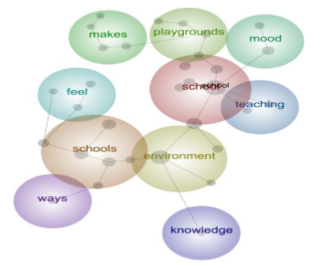Impact of Inclusion of Information and Communication Technologies in School Facilities and Effective Learning of Students in Green School
Keywords:
School facilities, ICT, Technology-enhanced learning, Green schools, Mood, Health-promoting schoolsAbstract
Future leaders of the nation, teachers and students are progressively exposed to think about sustainable practices and challenges in schools around the world to reconsider and redefine their missions, to modify and restructure their teaching and learning practices and campus life. Despite the increasing quantity of research on green schools, there has been comparatively less published literature about how teachers and learners in a green school use technology enabled methodology, especially from a holistic point of view. This study focuses on how school facilities use technology-enabled learning that might improve learning outcomes and health & well-being as an essential component of learning in Green Schools. 21 personal interviews were conducted as part of this study, which employed a case-based methodology. The target age group was determined and the age group of the selected students was set at thirteen to fourteen years, who were studying in seventh and eighth grade. The data collected by personal interviews was analyzed by using Leximancer tool. It was perceived that the facilities offered by Green schools are profoundly beneficial for affecting the learning outcomes by influencing the attitude of students. By providing context for our observations, we emphasize and conclude that as a learning platform green schools, can help to affect children's mood and thus improve their learning outcomes while maintaining their physical, mental, emotional, and social well-being. In nutshell, the results would apprise and assist decision-makers including policy-makers, building specialists, architects and teachers in designing green strategies and polices for Green schools.
Downloads
References
Retrieved on February 02, 2022, from https://gujecostat.gujarat.gov.in/
Retrieved on February 02, 2022, from http://gujarat-education.gov.in/ssa/projects/green_school.htm
Retrieved on February 02, 2022, from http://gujarat-education.gov.in/ssa/projects/sarva_siksha_abhiyan.htm
Retrieved on February 02, 2022, from https://sites.psu.edu/ceepa/2015/06/07/the-importance-of-school-facilities-in-improving-student-outcomes/
Retrieved on May 18, 2022, from (https://naaee.org/eepro/research/eeworks/student-outcomes)
Alexander, R. (2012). Environment Education for Sustainable Development in selected schools of Puducherry and Cuddalore regions India.
Barr, S., Leigh, K., & Dunbar, B. (2011). Green Schools that Teach. Institute for the Built Environment, Colorado State University.
Chopra, R. (2016). Environmental Degradation in India: Causes and Consequences. International Journal of Applied Environmental Sciences, 11(6), 1593-1601.
Freiberg, H. J. (1999). School Climate: Measuring, improving and sustaining healthy learning environments (pp.49-64). Falmer Press, London.
Gordon, D. (2010). Green schools as High Performance Learning Facilities.
Grimmette, K. A. (2014). The Impacts of Environmental Education on Youth and their Environmental awareness. Environmental Studies Undergraduate Student Theses. 135. Retrieved on May 15, 2020, from https://digitalcommons.unl.edu/envstudtheses/135
Kats, G. (2009). GREEN SCHOOL DESIGN: BETTER FOR HEALTH AND EDUCATION...AND MORE COST-EFFECTIVE. Retrieved on May 15, 2020, from https://www.ecoliteracy.org/article/green-school-design-better-health-and-educationand-more-cost-effective
National Research Council. (2007). Green Schools: Attributes for Health and Learning. Washington, DC: The National Academies Press. https://doi.org/10.17226/11756.
NCERT. (2015-16). A Report on A Study of Good Practices on Greening of Schools. Retrieved on May 15, 2020, from https://ncert.nic.in/dee/pdf/Green_School_Report.pdf
Olson, S. K. (2003). The Impact of Sustainable Buildings on Educational Achievements in K-12 Schools. Leonardo Academy Cleaner and Greener Program Report.
Rickinson, M. (2002). Environment Education: Recent Research on Learners and Learning. NFER, NFER. Retrieved on Jan 15, 2020, from http://www.327matters.org/sustainability/Docs/Rickinson.pdf
Roberts, N. S. (2009). Impacts of the National Green Corps Program (Eco‐Clubs) on students in India and their participation in environmental education activities. Environment Education Research, 15(4), 443-464.
Rudd, P., Reed, F., & Smith, P. (2008). The effects of the school environment on young people's attitude towards education and learning. National Foundation for Educational Research.
Schneider, M. (2002). Do School Facilities Affect Academic Outcomes? Washington, D.C: National Clearinghouse for Educational Facilities. Retrieved on May 18, 2020, from http://www.edfacilities.org/pubs/outcomes.pdf.
Sharma, K., & Pandya, M. (2014). Towards a Green School on Education for Sustainable Development for Elementary Schools. Retrieved on January 15, 2020, from https://ncert.nic.in/dee/pdf/Towards%20A%20green%20School.pdf
Shobeiri, S., Omidvar, B., & Prahallada, N. (2007). A Comparative Study of Environmental Awareness among Secondary School Students in Iran and India. International Journal of Environment Research, 1(1),28-34.Retrieved on May 15, 2020, from http://www.bioline.org.br/pdf?er07005
Siddiqui, T. Z., & Khan, A. (2015). Environment Education: An Indian Perspective. Research Journal of Chemical Sciences, 5(1).
Singh, A. (2011). Study of Environmental Education among the Senior secondary students. International Journal of Educational Planning & Administration, 1(2), 99-107. Retrieved on May 15, 2020, from https://www.ripublication.com/ijepa/ijepav1n2_2.pdf
Tyagi, S., Garg, N., & Paudel, R. (2014). Environmental Degradation: Causes and Consequences. European Researcher. 81. 1491. 10.13187/er.2014.81.1491.
Verma, R., & Razdan, A. (2018). Role of Tablets as Mood Elevators in the Perception Towards Green Schools: An Exploratory Research on the Students of Green Schools in Gujarat. In &. P. S. Dasgupta, Optimizing millennial customer engagement with mood analysis (pp. 69 - 97). IGI Global.

Downloads
Published
How to Cite
Issue
Section
License
Copyright (c) 2023 Rekha Verma, Naveen Sharma

This work is licensed under a Creative Commons Attribution-ShareAlike 4.0 International License.
All papers should be submitted electronically. All submitted manuscripts must be original work that is not under submission at another journal or under consideration for publication in another form, such as a monograph or chapter of a book. Authors of submitted papers are obligated not to submit their paper for publication elsewhere until an editorial decision is rendered on their submission. Further, authors of accepted papers are prohibited from publishing the results in other publications that appear before the paper is published in the Journal unless they receive approval for doing so from the Editor-In-Chief.
IJISAE open access articles are licensed under a Creative Commons Attribution-ShareAlike 4.0 International License. This license lets the audience to give appropriate credit, provide a link to the license, and indicate if changes were made and if they remix, transform, or build upon the material, they must distribute contributions under the same license as the original.





